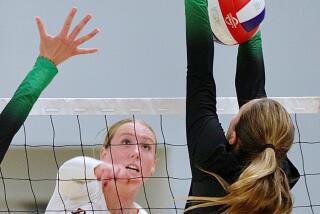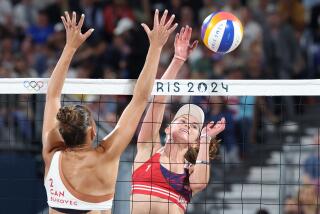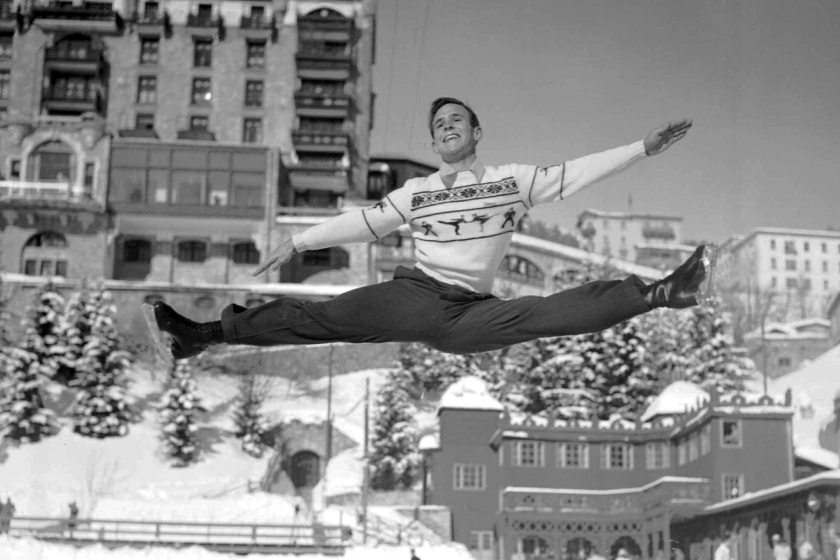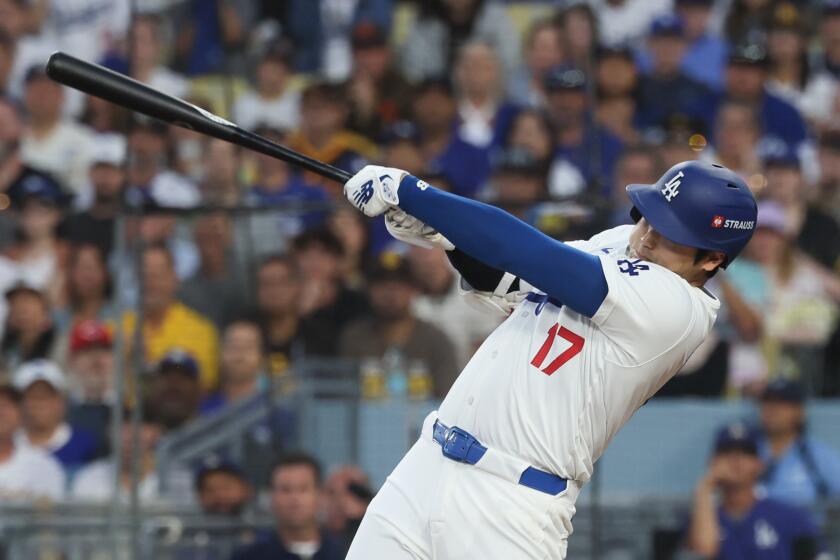May, McPeak Battle System
- Share via
The best U.S. women’s beach volleyball team might not qualify for the Olympics.
First in results, first in money earned, third on the Olympic qualifying list. That’s where Costa Mesa’s Misty May and Manhattan Beach’s Holly McPeak stand. One spot removed from the Olympics.
May and McPeak have done better in 2000 on the FIVB Tour, the international traveling show that serves as the Olympic qualification for all beach volleyball teams, than any other Americans. Problem is, this qualifying process began in January of 1999.
“It’s a crazy system,” McPeak says.
To qualify for the Olympics, teams need to accumulate points on the FIVB tour of events over a two-year period. This tour only includes one U.S. stop. The U.S. Olympic beach volleyball teams--men’s and women’s--will be chosen without the teams staying home for more than a few days in two years. Also, only two teams per country (with the exception of host Australia) are allowed. While the United States and Brazil dominate the men’s and women’s world rankings, only two men’s teams and two women’s teams from each country will be in the Olympics.
“This system makes sense for every country in the world but two,” says San Clemente’s Karch Kiraly, who, with partner Adam Johnson, has a tenuous hold on the No. 2 U.S. spot among the men. “It makes sense for every country but the United States and Brazil.”
When May and McPeak joined forces last fall, nobody thought they had a chance to make the Olympics, not after having missed the 1999 portion of the FIVB tour.
May graduated from Long Beach State in the spring of 1999 and spent most of last summer with the U.S. indoor national team. Unhappy with the structure of the team and with her role on it, May came home from Colorado last fall, came home to her roots on the beach.
McPeak, the winningest U.S. woman over the last four years, was looking for a partner. The youngster with the fresh legs and wide-eyed excitement and the veteran who demands a partner do 400 stomach crunches if caught eating a candy bar or a bag of chips, found each other and decided to try the impossible.
“I don’t think anybody expected Holly and Misty to have a chance,” said Tim Simmons, public relations director for the USA Volleyball beach operations. “Really, no one thought they could do it. What people failed to understand, though, was that Holly has such a tremendous work ethic and desire to win. The questions were mostly about Misty. Could she handle the transition from indoor to outdoor?
“Studies have been done saying it takes 3.4 years for a person to make that transition. And there’s the maturity issue. Was Misty mature enough to be traveling the world?”
We have the answers to those questions. Yes and yes. In Berlin this weekend, if May and McPeak finish fourth or higher and Liz Masakayan and Elaine Youngs, who are second on the Olympic qualifying standings, don’t make the semifinals, May and McPeak will be second. With a bullet. They just keep moving up.
There are five more qualifying tournaments between now and mid-August. May and McPeak are within 200 points of second place while only having played seven events. Teams are allowed to count their top eight events of 17 total tournaments.
This season, May and McPeak have a 65-13 record. That’s a winning percentage of .833. Annett Davis and Jenny Johnson Jordan, who are in first place, are 46-17 this year (.730), while Masakayan and Youngs are 31-20 (.608).
At the six FIVB tournaments this year, the Davis/Johnson Jordan team has finished 13th, 3rd, 2nd, 4th, 4th and 3rd. Masakayan and Youngs have finished 1st, 9th, 7th, 9th, 5th and 9th. May and McPeak have finished 5th, 2nd, 5th, 2nd, 2nd and 1st.
The first-place victory for May and McPeak came at the most recent tournament, in Chicago two weeks ago, when they beat the world’s top-ranked team, Brazil’s Adriana Behar and Shelda Bede. Add up those FIVB finishes: Davis and Jordan total 29; Masakayan and Youngs total 40; May and McPeak 17.
But that’s only in 2000. May and McPeak only managed to play in one tournament in 1999, last fall shortly after they became a team. They finished ninth. They’ve done better than that every time out this season, but they also have no room for error, no chance for a bad week and a score to discard.
It would be a real injustice if May and McPeak don’t play in the Olympics. Luckily for this unwieldy sport, this new, charismatic team has become very, very good very, very fast. Who wants to explain why a team that performed at a medal-winning level all year couldn’t play in the Olympics?
In no other sport do results two years before the Olympics count toward qualifying. You can’t predict Olympic success two years in advance. Not in any sport.
As Kiraly explains, this lengthy process is set up to benefit the sport in countries where it is not successful. The FIVB, the sport’s governing body, wants its own international tour to succeed. So they’ve used force: Don’t play in our events, don’t travel around the world, then don’t go to the Olympics.
When you look at the men’s qualifying rankings now, seven of the top 24 teams will not be eligible for the Olympics.
At least May and McPeak seem close to making the Games. The men’s Olympic draw won’t be so lucky.
A new Brazilian team of Marcio Araujo and Benjamin (he goes by one name) have the most podium finishes this year of any team on the FIVB circuit: one gold medal, three silvers, one bronze. But Araujo and Benjamin are too far behind two other Brazilian teams to make the Olympics.
“That’s a team capable of medaling,” Kiraly says, “and they won’t be at the Games. That’s not good for anybody. As a sport, don’t you want your best athletes at the greatest showcase? The Olympics shouldn’t be about affirmative action. At least not to this degree.”
Masakayan, who is recovering from a bad cold and who said she and Youngs pulled out of the Seal Beach event to rest up for the final five FIVB tournaments, says there should be a better way to do this.
In 1996 the U.S. held an Olympic trial, something the host country can do. Most players agree that isn’t the best way. One tournament, winners take all. One bad day and you’re done.
“But there must be something in between,” Masakayan says. “Two years is too long. Not knowing who will go until the middle of August, that’s really late. It’s been awfully grueling, awfully long and awfully confusing.”
A fan at last weekend’s Beach Volleyball America tour stop at Seal Beach, was watching May and McPeak win on Saturday. “Do they have a chance to medal at the Olympics,” the man asked a friend.
“They might not go to the Olympics” his friend said.
“But they’re the best girls out here,” the man said. “That’s crazy if they don’t go.”
Exactly.
*
Diane Pucin can be reached at her e-mail address: [email protected]
More to Read
Go beyond the scoreboard
Get the latest on L.A.'s teams in the daily Sports Report newsletter.
You may occasionally receive promotional content from the Los Angeles Times.






